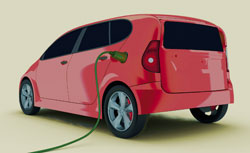Scientists in Japan have made an electrode for a lithium-air battery using a pencil. The advance could bring efficient, environmentally friendly and safe batteries for electric vehicles a step closer.
Lithium-air batteries have the potential to produce enough energy to power an electric vehicle, but the amount of energy is a safety concern. Contamination in lithium batteries can result in unstable and high energy reactions, and the current lithium-air batteries are vulnerable to decomposition and burn-out.

Haoshen Zhou and Yonggang Wang at the National Institute of Advanced Industrial Science and Technology in Tsukuba, have designed a battery in which the lithium is encapsulated by an organic electrolyte topped with a ceramic protection layer. The ceramic layer acts as a solid-state electrolyte upon which the team simply drew a 2D cathode using a graphite pencil. Zhou says that ‘removing and redrawing the novel air electrode is simple.’
Read the Chemistry World article by Harriet Brewerton in full
Or read the Energy & Environmental Science paper
To draw an air electrode of a Li–air battery by pencil
Yonggang Wang and Haoshen Zhou,
Energy Environ. Sci., 2011, DOI: 10.1039/c0ee00759e










